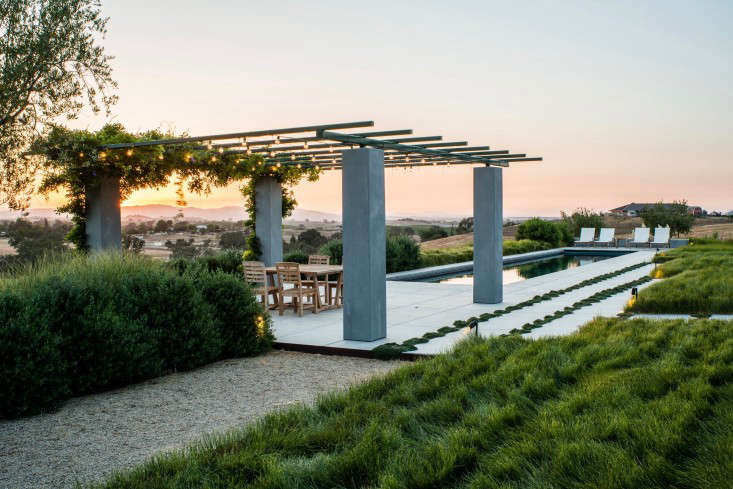Carex: “True Sedge”
Carex works and plays hard. As the sedge family’s most popular member, it thrives in most of the world and can be seen hanging near water or resting in the shade. It’s a versatile grass and can be used as turf, to fight erosion, or as a volunteer in a bioswale. Carex punctuates meadows, populates sedgelands, and works well in a container, bringing hairlike texture or variegation to a fall pot. The sedge (cyperaceae) family has thousands of known species in nearly a hundred genera, but only Carex is called “true sedge.”
At first glance, sedges may look like grasses or rushes, but aren’t. To spot a sedge, just remember the rhyme: “Sedges have edges and rushes are round, but grasses have nodes from their tips to the ground.” The “edges” refer to sedge stems, which are triangular in cross section. When working with sedges, sometimes it pays to wear gloves, because those edges can be sharp.

Above: Carex pansa is often used as a lawn replacement and can look lush, particularly at dusk. Photograph by Drew Kelly, courtesy of Third Nature Studio.
Though Carex are perennials, as with most grasses and grass-like plants it’s important to know whether your species is a cool- or warm-season variety. That will guide your horticultural care.
Above: Carex evergold ambles alongside a stepping stone path. Photograph by Heidi Bertish. For more of this garden, see Garden Designer Visit: A Study in Green by Franchesca Watson.

Above: European Meadow Sedge (C. remota) provides a durable groundcover despite its fine-textured appearance. Photograph courtesy of Greenlee and Associates.
Above: Photograph courtesy of Hoffman Nursery.
Some Carex species require damp or wet conditions while others are relatively drought-tolerant. Carex appalachica, above, is native to woodlands in the eastern United States. When planted en masse or on slopes, it curves and intermingles beautifully. It’s often used as a lawn substitute, does well in shade, and thrives in dry to average soil.

Above: Carex testacea ‘Prairie Fire’ gets its game on with super color and texture contrast alongside a gravel path. Photograph courtesy of Hoffman Nursery.
New Zealand sedges can usually take more sun and offer beautiful foliage colors, ranging from carmel to deep red-bronze.
Cheat Sheet
- The genus Carex was introduced by the father of modern taxonomy, Carl Linnaeus, in his Species Planetarium in 1753. It set off a rush of study by botanists.
- During the first human expedition to the South Pole in 1911, dried mixes of several Carex specimens were used as insulation in footwear.
- Sedges have been referenced by literary greats, appearing in W. B. Yeats 1899 poem “He Hears the Cry of the Sedge” and in two of Shakespeare’s plays: Much Ado About Nothing and The Tempest.
Carex texensis and Carex remota blend with other perennials in this meadow garden at Hess Winery in Napa, California, designed by John Greenlee. Monocultures are rarely seen in nature, so mixing it up with sedges makes sense. Photograph courtesy of Greenlee and Associates.
Keep It Alive
- Carex can thrive in both wet and dry conditions—check your species.
- Some people use wide-toothed combs to tidy up hairy Carex.
- Carex rarely need fertilizer, grow rapidly and can be moved easily. If you mow, use a sharp blade and cut no lower than two-thirds of the plant’s height. Cut back only if the foliage starts looking tired.
Above: Photograph by Meredith Swinehart.
Carex comans ‘Amazon Mist’ grows in a small, neat clump, making it perfect for pairing in containers. It has thin, pale green and silver blades, giving it a shimmery look. Here it’s combined with golden yarrow.
Above: A mix of Carex—including ‘Red Rooster,’ ‘Bronzier,’ and ‘Buffalo Gold’—along with Juncus ‘Blue Arrows’ and Isolepsis ‘Live Wire’ burst from these fall planters. Photographs courtesy of Ball Horticultural.
Above: Carex morrowii ‘Ice Ballet’ pops in the landscape, particularly in the shade. Photograph courtesy of Hoffman Nursery.

Above: Carex grayi ‘Gray’s Sedge’ produces unique, pale green seed heads that resemble three-dimensional, one-inch stars. The sedge grows to three feet. Photograph courtesy of Hoffman Nursery.
Above: Carex bicknellii develops copper colored, oval seedheads. Photograph courtesy of Hoffman Nursery.
Sedges bloom early in spring, providing wildlife their first native grass meals of the season.
For expert advice on creating a garden with grasses, see Expert Advice: 8 Tips for a Meadow Garden from Grass Guru John Greenlee















Have a Question or Comment About This Post?
Join the conversation